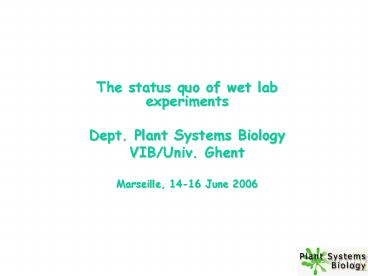The status quo of wet lab experiments - PowerPoint PPT Presentation
1 / 8
Title:
The status quo of wet lab experiments
Description:
thaliana cell culture, aphidicolin block, 10 time points. Synchronization quality ... Transcriptional response to auxin in Arabidopsis roots has been earlier ... – PowerPoint PPT presentation
Number of Views:46
Avg rating:3.0/5.0
Title: The status quo of wet lab experiments
1
- The status quo of wet lab experiments
- Dept. Plant Systems Biology
- VIB/Univ. Ghent
- Marseille, 14-16 June 2006
2
Cell cycle transcript profiling
- thaliana cell culture, aphidicolin block, 10 time
points - Synchronization quality checked by qPCR (30
genes) - 2 biological repeats, 4 technical repeats,
interwoven loop design - CATMA arrays
- Unsatisfactory hybridization quality
3
DNA damage checkpoint
- Substituted with DNA replication checkpoint
- thaliana root tips, wild type and 2 Wee1 mutants
- Hydroxyurea treatment, 3 time-points
- 4 biological repeats, pooled pair wise
- Affimetrix arrays
- Samples are ready for hybridization
4
Cell cycle exit/entry in response to nutrients
availability
Phosphate starvation experiments have been
performed elsewhere No experiments planned
5
Cell cycle exit/entry in response to
extracellular signaling
Transcriptional response to auxin in Arabidopsis
roots has been earlier investigated in the
Department (outside DIAMONDS) No experiments
planned
6
Proteome analysis
TAP Technology fully established, 3
baits/week Goal 125 baits 14 baits fully
processed, 2 baits no interactions, 12 baits 2-50
interactions 65 baits in the pipeline, 50 more
will be chosen among the preys Dynamics will be
studied for a few baits (CDKA1, CDKB11,
CKS1?) Y2H
7
Functional validation and characterization
131 genes expressed specifically in proliferating
cells (identified outside DIAMONDS) Analysis
focused on genes of unknown function 20 genes
selected 3 small families 10 unique genes
(all possessing mammalian homologues) T-DNA
insertions found in 12 genes, some have growth
phenotypes, analysis in progress Complementary
approach amiRNA, constructs are ready, no
results yet
8
(No Transcript)































